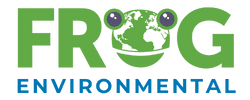Industrial facilities across California are entering another rainy season, and with it, another round of stormwater sampling. Whether you’re new to the Industrial General Permit (IGP) or a seasoned pro, one truth remains: accurate samples are the backbone of compliance.
Poor sampling practices can lead to skewed results, benchmark exceedances, and costly follow-up actions. But with the right preparation (and the right partner), your facility can achieve consistent, reliable data and stay inspection-ready all season long.
Here’s how to set your team up for a successful sampling season, and how Frog Environmental can take care of it all for you.
1. Watch the Forecast and Plan Ahead
The first rule of stormwater sampling: be ready before the rain hits. Under the IGP, samples must be collected during Qualifying Storm Events (QSEs), storms producing at least 0.1 inch of rainfall with 48 hours of dry antecedent conditions.
Monitor local forecasts daily.
Set up automated rain-alerts to notify your compliance team.
Coordinate staff or sampling coverage in advance so someone is ready.
Keep your sampling kit stocked, labeled, and ready (bottles, gloves, chain-of-custody forms, etc.).
Being reactive during a storm often leads to missed samples or procedural errors.
2. Calibrate and Inspect All Equipment
Your data quality depends on your tools.
Check that all sample bottles are clean, properly labeled, and within expiration or use windows.
Ensure meters (pH, conductivity, turbidity) are properly calibrated per lab protocols.
Replace tubing, pumps, or connectors showing wear.
Maintain a documented equipment checklist to show due diligence if regulators ever request it.
3. Collect Samples Correctly (Time + Technique)
Time is critical, and protocols matter.
Samples are required within the first hour of discharge (or as allowed by site conditions). Plan for quick access and safe entry.
Identify and pre-label your sampling points in advance, and ensure they’re free of obstructions.
Avoid stagnant pools or re-entrained water. Only sample flowing runoff that represents the discharge.
Use gloves, minimize contact with bottles, and record all metadata (time, location, sampler name).
Maintain strict chain-of-custody documentation.
Small procedural errors can invalidate samples, so planning and training are key.
4. Keep Samples Cold & Ship Promptly
Proper sample preservation is often overlooked and errors here can ruin results.
Store samples on ice immediately after collection.
Use insulated coolers with sufficient ice packs to maintain low temperature.
Ship to the certified lab within 24 hours.
Track and document sample temperatures and chain-of-custody.
Improper handling or delays can compromise metals, bacteria, or other sensitive analyses.
5. Review Results, Identify Trends, and Adjust BMPs
Once lab reports are back:
Compare to previous seasons to spot upward trends in key pollutants (e.g. zinc, copper, TSS, oil & grease).
Don’t just file results, perform a root cause evaluation when you see increases.
Adjust your BMPs early to avoid ending up in Level 1 or Level 2 Exceedance Response Action (ERA).
Consider structural, treatment, or process changes if frequent exceedances appear.
Full-Service Solution: Let Frog Handle It All
Here’s where Frog Environmental stands apart. We don’t just advise, we execute.
From sampling through reporting, we’re your compliance partner.
End-to-End Stormwater Sampling & Reporting
On-site sampling during qualifying storm events
Proper handling, preservation, and lab coordination
Full chain-of-custody documentation and QA/QC
Upload of results and certification in SMARTS
Annual reports, visual observations, and site inspections included
Staff training in monitoring protocols, BMPs, and SMARTS requirements
Real-time rain event alerts and scheduling support
Because we cover everything (field work, lab logistics, and SMARTS reporting), your team can focus on operations.
Advanced BMPs & Treatment Systems
Frog designs and manufactures BMPs and treatment systems in-house, so you get tailored solutions backed by real engineering.
StormPROOF® treatment systems: modular systems engineered to remove TSS, oil/grease, metals, and even nutrients depending on configuration
Proprietary media and filtration technologies such as MetalPROOF™ media socks, CarbonPROOF™ socks, and other in-house BMP products
Implementation support, maintenance, and performance monitoring built in
You get a solution designed to your site, not “off the shelf” band-aids.
Broad EHS / Compliance Expertise
In addition, Frog handles:
SWPPP development and updates (aligned with IGP and TMDL requirements)
Exceedance Response Actions (Level 1, Level 2) and technical reports
Hazardous Materials Business Plans (HMBP) and Spill Prevention Control & Countermeasure (SPCC) plans
Ongoing compliance consulting, inspections, and trainings
For nearly 30 years, Frog has worked with over 1,500 clients across California and expanded services into WA, OR, AZ, and NV.
